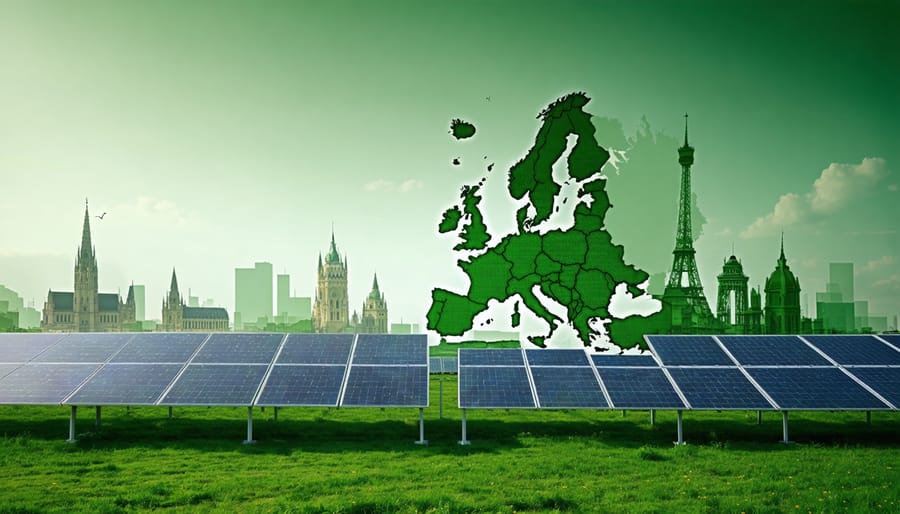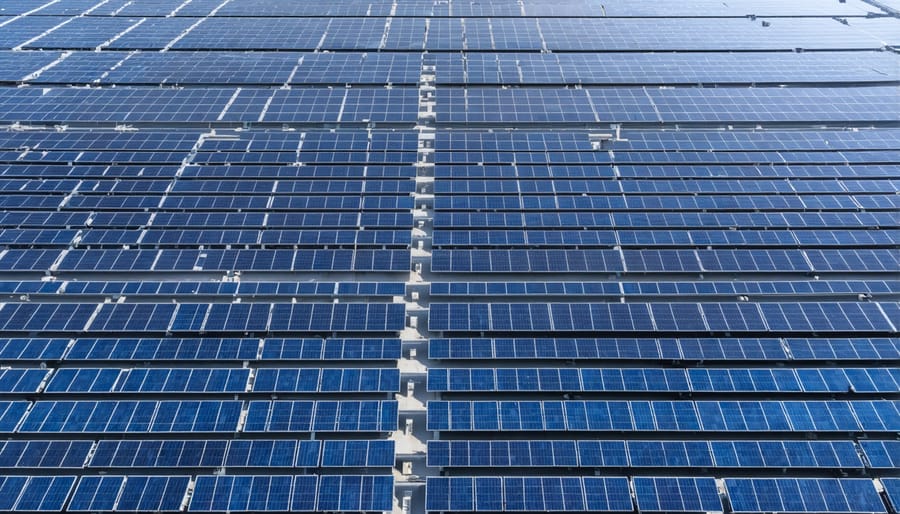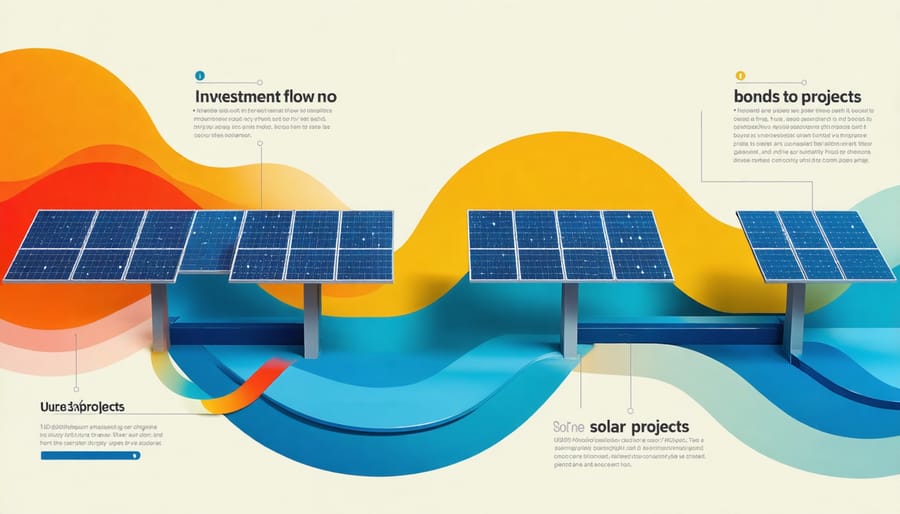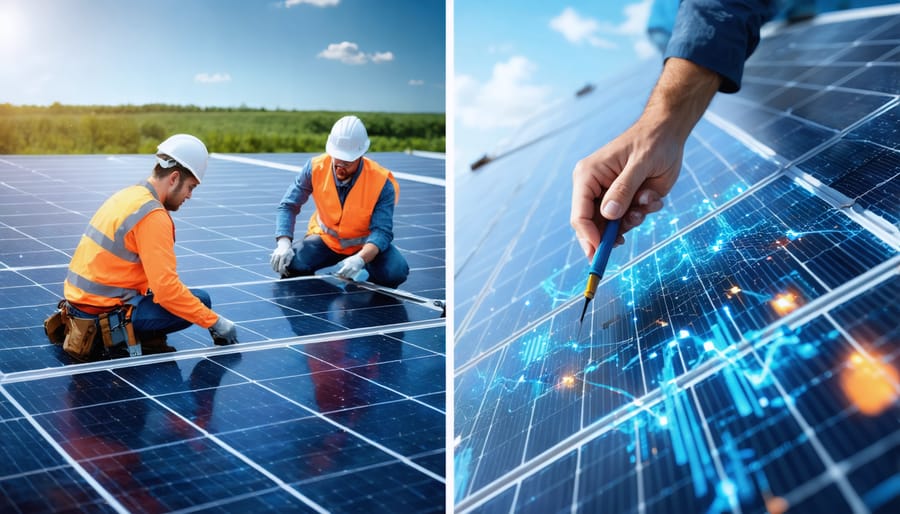Green Bonds Are Powering Europe’s Solar Revolution (Here’s How to Invest)

Energy bonds offer a compelling gateway into sustainable infrastructure financing, combining stable returns with environmental impact. As the renewable energy sector experiences unprecedented growth, solar energy financing through green bonds has emerged as a cornerstone investment vehicle, particularly across European markets.
These fixed-income securities, backed by renewable energy projects, typically yield 4-7% annually while providing essential funding for solar installations, wind farms, and energy storage facilities. For institutional investors and forward-thinking individuals, energy bonds represent a dual opportunity: portfolio diversification with predictable returns and direct participation in the clean energy transition.
The European Union’s commitment to achieve carbon neutrality by 2050 has catalyzed the energy bond market, creating a robust framework for sustainable investment. With standardized green bond criteria and increasing market liquidity, these instruments have evolved from niche products into mainstream investment options. Understanding this rapidly maturing market is crucial for investors seeking both financial returns and environmental impact in their portfolio allocation strategies.

What Makes Solar Energy Bonds Different?
Risk-Return Profile
Energy bonds in the solar sector present a unique risk-return profile that combines elements of traditional fixed-income investments with sustainable energy market dynamics. Within European renewable energy markets, these investments typically offer annual returns ranging from 3% to 7%, depending on project scale and duration. Government backing through feed-in tariffs and renewable energy incentives provides an additional layer of security, significantly reducing default risks.
Most solar energy bonds are asset-backed securities, with the physical infrastructure serving as collateral. This tangible asset base, combined with long-term power purchase agreements, creates a stable revenue stream that underpins investment safety. However, investors should consider factors such as technology obsolescence risk, regulatory changes, and weather-dependent performance variations.
The involvement of established financial institutions and insurance coverage further enhances investment security. Many projects incorporate performance guarantees and maintenance contracts, ensuring consistent energy production and revenue generation throughout the bond’s lifetime. This comprehensive risk mitigation framework makes solar energy bonds particularly attractive for conservative investors seeking sustainable, long-term returns.
Environmental Impact Metrics
Environmental impact metrics play a crucial role in evaluating energy bonds’ performance beyond financial returns. Modern green energy investments typically track key sustainability indicators, including annual carbon dioxide emissions avoided, equivalent trees planted, and renewable energy capacity added to the grid. For instance, a typical €1 million energy bond investment in solar projects can offset approximately 800-1,000 tonnes of CO2 emissions annually.
European energy bonds often adhere to standardized measurement frameworks, such as the EU Green Bond Standard and Climate Bonds Initiative criteria. These frameworks ensure transparent reporting of environmental benefits, including metrics like water conservation, biodiversity protection, and waste reduction during project implementation.
Investors can access detailed environmental impact reports that quantify their contribution to sustainability goals. Many European solar projects now feature real-time monitoring systems that track and report environmental benefits, providing investors with tangible evidence of their investment’s positive impact. This data-driven approach helps stakeholders align their portfolios with EU climate targets while supporting the transition to renewable energy sources.
Investment Options in European Solar Bonds

Direct Project Bonds
Direct project bonds offer investors a unique opportunity to participate in specific solar installations, providing a tangible connection to renewable energy development. These financial instruments allow investors to fund individual solar projects, from utility-scale installations to community solar farms across Europe.
Typically, direct project bonds are structured with terms ranging from 5 to 20 years, offering fixed-income returns that correlate with the project’s power generation and revenue streams. Interest rates generally fall between 3% and 7%, depending on project scale, location, and risk profile.
These bonds are particularly attractive because they’re backed by physical assets and power purchase agreements (PPAs), which provide stable, predictable cash flows. European investors can often participate with minimum investments starting from €1,000, making them accessible to both individual and institutional investors.
Key benefits include:
– Direct impact on sustainable energy development
– Regular interest payments
– Asset-backed security
– Transparent project outcomes
– Geographic diversification options
However, investors should consider factors such as project completion risk, operational performance, and regulatory changes that might affect returns. Due diligence is essential, focusing on the developer’s track record, technology quality, and maintenance agreements.
Many European nations offer additional incentives for direct project bond investments, including tax benefits and priority grid access for supported installations, enhancing the overall investment proposition.
Green Bond Funds
Green bond funds offer an accessible entry point for investors looking to support solar energy projects while maintaining portfolio diversity. These professionally managed investment vehicles pool resources from multiple investors to finance various renewable energy initiatives, with a significant focus on solar installations across Europe.
Leading European asset managers have launched specialized green bond funds that prioritize solar energy projects, typically offering annual returns between 3% and 6%, depending on the fund’s structure and risk profile. These funds undergo rigorous screening processes to ensure investments align with established green bond principles and contribute meaningfully to sustainable energy development.
A key advantage of green bond funds is their liquidity compared to direct project investments, allowing investors more flexibility in managing their positions. Many funds maintain a balanced portfolio of solar projects across different development stages, from utility-scale installations to community solar initiatives, helping mitigate risk through diversification.
For European investors, these funds often provide tax advantages and may qualify for sustainable finance incentives under EU regulations. Fund managers actively monitor project performance, technical innovations, and market conditions, adjusting portfolios to optimize returns while maintaining strict environmental criteria.
Recent market trends show increasing institutional investor participation in green bond funds, particularly those focused on solar energy, indicating growing confidence in this investment category’s long-term potential and stability.
Municipal Solar Bonds
Municipal solar bonds represent an innovative financing mechanism that enables local governments and communities to fund solar energy projects while offering citizens a chance to invest in sustainable infrastructure. These bonds typically finance large-scale solar installations on public buildings, schools, and community spaces, providing dual benefits of clean energy generation and stable investment returns.
In Europe, municipal solar bonds have gained significant traction, with success stories emerging from cities like Vienna, Copenhagen, and Barcelona. These investments usually offer returns between 2% and 5% annually, depending on the project scope and duration. The minimum investment thresholds are often set lower than traditional bonds, making them accessible to a broader range of investors.
What makes these bonds particularly attractive is their connection to tangible local projects. Investors can literally see their money at work in their communities, from solar panels on local schools to community solar farms powering municipal buildings. The bonds typically come with terms ranging from 5 to 15 years, offering predictable income streams backed by power purchase agreements and government guarantees.
For European communities, these bonds serve as powerful tools for achieving climate targets while fostering citizen participation in the energy transition. They create a virtuous cycle where local investment supports local renewable energy development, reducing carbon emissions while generating sustainable returns for residents.

Key Considerations for Investors
Technical Assessment
A robust technical assessment forms the cornerstone of successful energy bond investments, particularly in solar projects. This evaluation process examines multiple critical factors to determine project viability and long-term sustainability. Primary considerations include the solar technology’s proven track record, manufacturer reliability, and performance metrics under various environmental conditions.
Investors should focus on projects utilizing Tier 1 solar panels and inverters with established performance histories. These components typically offer warranties ranging from 20-25 years, aligning with standard bond maturity periods. Equipment degradation rates, typically 0.5% to 0.7% annually for quality panels, must be factored into long-term yield projections.
Project location analysis is equally crucial, incorporating solar irradiance data, grid connection capabilities, and local regulatory frameworks. European sites require detailed assessment of seasonal variations and specific regional factors affecting energy generation potential. Modern monitoring systems and predictive analytics help validate technical assumptions and optimize performance.
The engineering team’s expertise and track record deserve careful scrutiny, as does the operations and maintenance (O&M) strategy. Best practices include regular performance reviews, preventive maintenance schedules, and clear protocols for addressing technical issues. Projects should demonstrate robust contingency plans for equipment failure or underperformance.
Environmental impact assessments and grid integration studies round out the technical due diligence process. These evaluate potential challenges like shadow effects, wildlife protection measures, and grid stability requirements. Successful projects typically incorporate advanced forecasting tools and smart grid technologies to enhance reliability and maximize returns while maintaining environmental compliance.
Financial Due Diligence
Before investing in energy bonds, thorough financial due diligence is essential to ensure informed decision-making and risk management. Understanding investment returns and profitability requires careful evaluation of multiple factors within the European renewable energy landscape.
First, assess the bond issuer’s financial health by examining their credit rating, debt-to-equity ratio, and historical performance. Look for transparent reporting and strong governance structures that align with EU sustainable finance regulations. Pay particular attention to the specific project metrics, including projected energy output, guaranteed feed-in tariffs, and operational cost forecasts.
Key risk factors to consider include regulatory changes, technology obsolescence, and market fluctuations. The European Union’s sustainable finance taxonomy provides a framework for evaluating green bonds, ensuring they meet standardized criteria for environmental impact and financial stability. Consider how these regulations might evolve and affect your investment.
Expected returns typically range from 3% to 7% annually, depending on the project scale and risk profile. However, returns can vary based on factors such as project location, technology efficiency, and government incentives. The minimum investment threshold often starts at €1,000, making these bonds accessible to various investor profiles.
Monitor the bond’s liquidity options and maturity period, typically ranging from 5 to 15 years. Consider whether the investment timeline aligns with your financial goals. Additionally, evaluate any early redemption penalties and trading restrictions that might affect your investment flexibility.
Remember that while green energy bonds offer stable returns and environmental benefits, they should be part of a diversified investment strategy aligned with your risk tolerance and investment objectives.
Future Outlook
The trajectory of energy bonds in Europe’s solar sector shows remarkable promise, with experts projecting substantial growth over the next decade. Recent analysis indicates that European solar market growth could exceed previous forecasts, driven by increasing renewable energy targets and supportive regulatory frameworks across the EU.
Investment opportunities in solar bonds are expected to diversify, with new financial instruments emerging to accommodate various investor profiles. The European Green Deal’s commitment to achieving climate neutrality by 2050 continues to fuel demand for sustainable energy investments, creating a robust foundation for solar bond market expansion.
Several key trends are shaping the future landscape: the introduction of innovative financing models, including community solar bonds and green securitization products; enhanced standardization of solar bond offerings, making them more accessible to retail investors; and the integration of digital platforms for improved transparency and easier trading.
Market analysts predict annual returns ranging from 4% to 7% for solar bonds over the next five years, depending on project scale and location. This attractive yield potential, combined with growing environmental consciousness among investors, suggests sustained market momentum.
The outlook is further strengthened by technological advancements in solar energy storage and distribution, which are expected to reduce project risks and increase overall returns. As the European Union continues to prioritize green energy transition, solar bonds are positioned to become an increasingly important component of sustainable investment portfolios.
Energy bonds represent a compelling opportunity for investors looking to combine financial returns with environmental impact in Europe’s growing renewable energy sector. By understanding the key aspects of energy bonds – from fixed-income characteristics to project-specific risks – investors can make informed decisions that align with their financial goals and sustainability objectives.
To get started with energy bond investments, consider these essential steps: First, evaluate your risk tolerance and investment timeline. Second, research available green bond offerings from reputable European institutions and energy companies. Third, diversify your portfolio by mixing different types of energy bonds and project scales. Finally, stay informed about regulatory changes and market trends affecting the renewable energy sector.
Remember that successful energy bond investment requires due diligence, including thorough assessment of project viability, issuer credibility, and market conditions. Working with financial advisors who specialize in sustainable investments can provide valuable guidance. As Europe continues its transition toward renewable energy, energy bonds offer a structured way to participate in and benefit from this transformative shift while contributing to a more sustainable future.
Leave a Reply